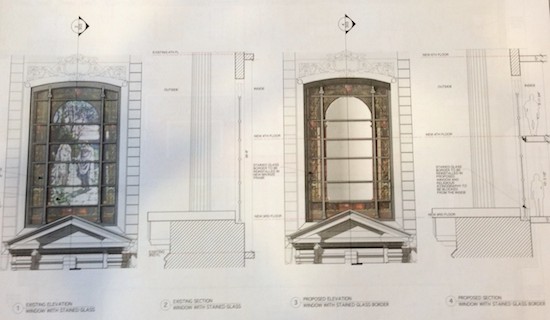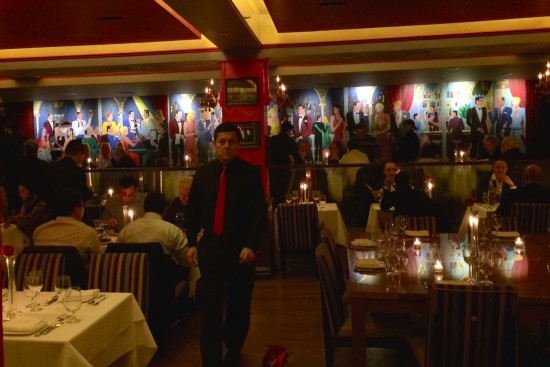Landmarks West sent out the following alert about the conversion of the old First Church of Christ at the corner of 96th street and Central Park West. The building is being gutted and developers are attempting to build condos inside, but they’ve faced resistance from the Landmarks Preservation Commission.
Dear Neighbors,
On Tuesday, March 10 at 10:00AM, there will be a Public Meeting, NOT a Public Hearing, at the Landmarks Preservation Commission (LPC) on the proposed residential conversion of the former First Church of Christ, Scientist at Central Park West and 96 Street. See the attached image – the applicants still plan on removing the historic stained glass windows.
The meeting will be at the LPC hearing room, at the following address:
Municipal Building*
1 Centre Street
9th Floor North
Your presence will speak volumes about the sustained level of concern about the slew of proposed changes to this Individual Landmark. LPC Chair Meenakshi Srinivasan refused to take public testimony at the February 10 “public meeting” (though she welcomed an extensive presentation by the applicant). That didn’t stop us from speaking up and walking out when it became clear that the application had strayed far from the standards of appropriateness established by the Commissioners at the December 9 public hearing. No vote was taken.
As the late Peter Jennings wrote in a 2003 letter to the LPC about proposed (and ultimately approved) changes to another Central Park West religious site:
“Here’s what else I hear on the street: that people have lost faith in the process –
the governing process – because they believe ‘the fix is in.’”It’s hard to keep faith, especially when the LPC shows signs of having other priorities besides landmarks preservation. But we must continue to call on the Landmarks Preservation Commission to:
- Preserve, don’t destroy this Carrere & Hastings Landmark
- Vote “no” to changes that serve only short-term development goals, not the long-term integrity of this Landmark
Many of you have signed letters to this effect. Please keep up the good work! It is important that Chair Meenakshi Srinivasan hear from as many people as possible. Please encourage more neighbors to copy and paste the letter below into an email to comments@lpc.nyc.gov (cc. l
andmarkwest@landmarkwest.org) to ensure the record shows the level of concern about the impact of this plan on one of New York’s most compelling individual landmarks. Visit LW’s blog for additional samples of letters and testimony.
*To get to the public meeting, take the Downtown 2 or 3 train to the Park Place Station, walk across City Hall Park until you reach the intersection of Centre & Chambers Streets. The Municipal Building is the wide stone building on the east side of the street. Use the north elevator bank. When you get to the 9th floor, follow the signs to the LPC hearing room.










raises the alarm here, but lets 3 historic townhouses worthy of designation be torn down just next door to be replaced with an ugly monstrosity that will damage the look and feel of the block far more then a few replaced windows.
Politics.
BTW, have any landmarks been designated since BDB?
Unfortunately the three townhouses were never landmarked, and are not part of the historic district which ends on the south side of 96th Street. As such it has no protections. The Church is a designated landmark, and one which has been considered one of the 10 most important landmarked churches in NY. It was designed by Carrere and Hastings who designed the NY Public Library, and the Frick. It is a very significant NY monument. There are many more changes to the exterior than just the redesign of the stained glass windows, one of which shows here has been attributed to John LaFarge. There are extensive plans to puncture the granite with numerous windows, including to the solid front piers. There are several structures to be added to the roof. The entrance will be moved to the rear of the building, and the front doorways will be individual windows to several private apartments. The north side will have 4 story curtain wall windows broken into the stone. The inside has been gutted and everything rare and irreplaceable has been removed. Is that what you think of as landmark preservation?
Sadly when a building is not landmarked, anything can be done to it, as in the townhouse which housed Rizzoli’s. Allowing a landmark to be defaced-that’s not supposed to happen, but seems to more and more often.
thank you for the fact-based commentary, Saving Grace.
I understand that, I am advocating that they BE included in the historic district. They should never have been left out.
If the area is indeed historic, there is no reason that both sides of one street are not landmarked.
The church is deserving of landmark status. Those townhouses aren’t.
I am a great lover of townhouses and brownstones but the three derelict ones on the north side of 96th street are not worthy of preservation. They sit in a district/area that has already been pillaged and ruined by superblocks, projects, terrible 60s/70s buildings and trying to keep the townhouses there will not rescue that neighborhood.
I agree with nathan. The south side WAS landmarked, I would think, because it is a much longer, near intact row. the 3 north side townhouses are much more derelict, partially de-stooped and de-corniced. I would assume those building may be empty, and need cost prohibitive renovations.
If that is true Nathan, then neither is the south side of 96th street. or many many buildings that are now landmarked as part of the district. The District is about the overall feel to the neighborhood. If this indeed a cohesive whole, then both sides create that whole. The new tower will do far more damage to the street vibe then the windows loss.
BTW, this is why folks don’t like LPC. Too much power on one hand and not enough on another. – I think the interior of the church should be have been landmarked BTW.
I wish there was a middle ground, a “landmark light” as it were.
The facades on the townhouses could be preserved with a prewar looking tower behind it.
Also, strategic neglect and decay or/and removal of ornamentation should not get an owner off the hook from landmarking
If you landmarked the interior of the church all you would get is a building that would never find another owner. Which would eventually get torn down because of neglect. Is that what you really want?
Agreed. These buildings need to be allowed to move on to the next useful phase of their lives. The alternative is to seal them up tight so that they can remain empty facades … their only purpose being to mutely maintain the appearance of what they once were.
The solution for the windows is to have them removed to a location where they can again be enjoyed again by people … forcing them to remain in place (where passersby can only see their dark street sides) so that a dwelling owner who may not want them is the only one who can see them is not a good alternative.
Support for religious institutions has eroded everywhere … the troubles at the Cathedral of St. John the Divine are another example … and it is not reasonable that we expect them to bear the maintenance of their structures just to support our views of them. They are not exactly turning a profit on their mission, and they receive only meager support from the communities.
Say that to Paris-no, how about Copenhagen, no maybe Amsterdam. We don’t preserve our landmarks, purely and simply because the real estate industry has more power in this city, than our government, or our citizens. We nearly lost Grand Central Station. Perhaps we should have built another Penn Station there instead, so that time could have marched on.
The interior of this church did not make it less valuable, but more valuable to anyone who could have purchased it. Unfortunately, no effort was ever made to offer it for sale to any other institution-another church, a museum, a Symphony Space. Instead in a very non-transparent process it was sold to a developer. And for that and no other reason, this landmark has been marred forever. The design of it in no way respects the structure, and the layout of the interior does little to entice a buyer. Buildings such as this are repurposed all the time for venues which are civic in nature. No effort was made to do this. And the very little intervention of the Landmarks Commission shows how little interest they really have in preserving landmarks in this city.
How do you know that the building wasn’t offered to another church, museum or cultural institution?
I’m sure the church would have been happy to sell it to a non-profit if they could come close to what the developer paid.
I think the process is weighing the need to redevelop the church in a way that makes it feasible for future use. Advocating for this property to stay exactly the same is advocating for its destruction.
That effort was made when the Christian Science Congregation was in residence. Hence it was sold to a church which was what the Christian Science Church wanted. They wanted it passed to a non-commercial use, and for the church to be preserved because they understood exactly what that landmark was. That effort was not repeated in the sale made to the present developer by the Crenshaw Church. Nor do I know of any effort made by any city agency to assist with finding such a buyer.
This beautiful building has a majesty sitting on the corner of W. 96th St. The proportions, the stain glass and the placement of the windows all add up to a wonderful example of Carrere & Hastings work.
The Landmark status should include the stained glass windows and the placement of the windows as they exist.
Please allow the exterior of the building to remain intact.
I totally agree with you Lori. But I’m afraid this is not to be. If people cared enough they would get involved in understanding the too cozy relationship between the Landmarks Commission, and the real estate industry before there isn’t a landmark left in its original state in this city.
If people really cared they would contribute large sums to maintain and protect the properties, rather than just complain about change.